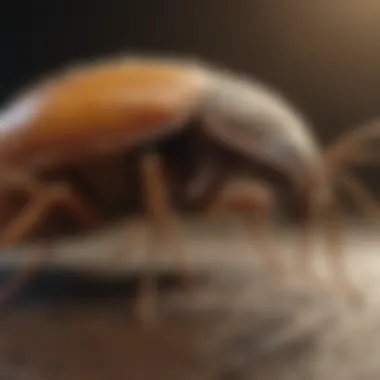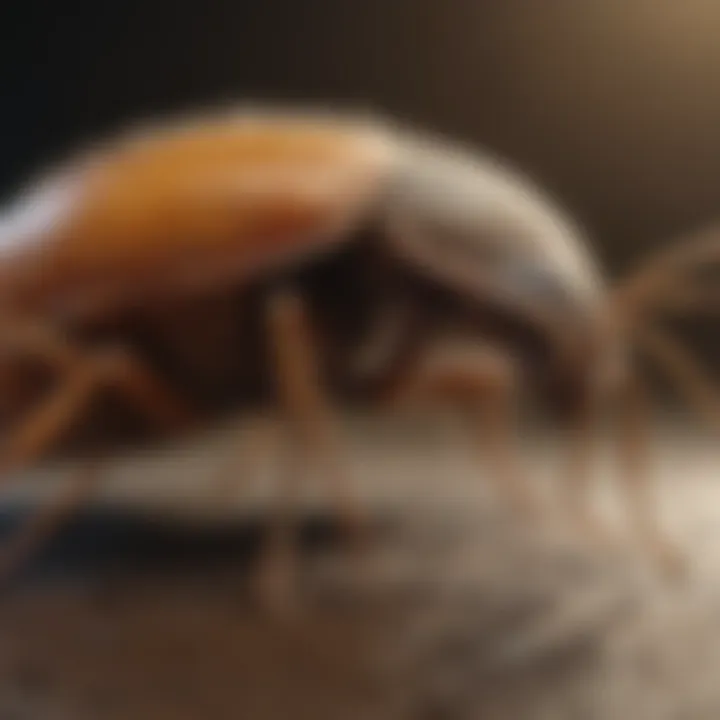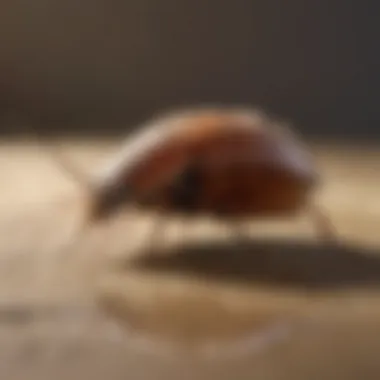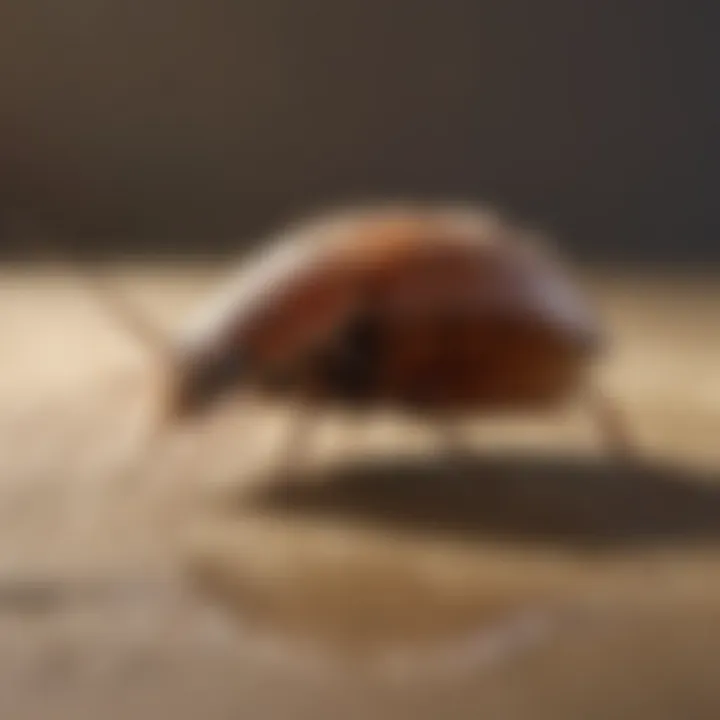Effective Strategies for Eliminating Fleas and Bed Bugs


Intro
Fleas and bed bugs present significant challenges for homeowners and renters alike. These pests infiltrate homes quietly, and their presence can lead to discomfort, sleepless nights, and health concerns. Understanding how to effectively manage and eliminate these nuisances is essential for maintaining a pest-free home. This article will provide practical methods to confront the issue, focusing on identification, prevention, and treatment options. Through this comprehensive guide, homeowners will gain insights that blend scientific study with practical application, improving their ability to deal with such infestations.
Understanding Pests
Definition of Pests
Pests, in the context of this article, refer specifically to fleas and bed bugs. Fleas are small, dark brown insects that feed on the blood of mammals and birds. They are known for their agility, capable of jumping many times their body length. Bed bugs, on the other hand, are flat, oval insects that are reddish-brown and primarily feed on human blood at night. Both pests thrive in warm environments where they can easily access their hosts.
Importance of Pest Identification
Accurate identification of these pests is crucial. Misidentifying the pest makes effective treatment difficult. Homeowners should observe the characteristics and habits of the pests they encounter. Fleas tend to leave small, itchy bites on their victims, while bed bugs often create clusters of bites on exposed skin. Recognizing these differences allows for more targeted pest control strategies.
Prevention Techniques
Home and Garden Preventative Measures
Preventing infestations is typically more effective than dealing with them after they occur. Here are several preventative actions:
- Regular cleaning and vacuuming: Frequent vacuuming helps remove flea eggs, larvae, and bed bugs from carpets and upholstery. Don't forget to dispose of the vacuum bag immediately.
- Wash bedding and fabrics: Regularly wash bed linens, pet bedding, and curtains in hot water. High temperatures can eliminate any existing pests.
- Seal cracks and crevices: Ensure that any gaps in walls, windows, and doors are sealed. This reduces areas where pests can hide and breed.
- Manage your garden: Maintain your yard by trimming grass and bushes. Fleas can be found in outdoor areas, especially if pets frequent those spaces.
Seasonal Prevention Tips
Seasonal changes impact pest activity. In summer, fleas reproduce rapidly due to warmth, while bed bugs are often more active in late spring and early fall. During these times, homeowners should take extra precautions:
- Inspect outdoor furniture and gear before bringing them indoors.
- Keep a close watch on travel belongings, as sudden infestations often come from traveling.
- Consider applying preventive treatments to indoor and outdoor areas during peak pest seasons.
Eco-Friendly Pest Control Solutions
Overview of Sustainable Practices
In the age of eco-consciousness, many homeowners seek sustainable pest control methods. Utilizing fewer harmful chemicals not only benefits the environment but can also enhance home safety.
Some sustainable practices include:
- Biological control: Introducing natural predators of fleas or bed bugs into the environment can help manage the pest population naturally.
- Use of essential oils: Certain essential oils, such as lavender or tea tree oil, can deter pests. However, effectiveness varies, and proper application methods are vital.
Natural Remedies and Their Effectiveness
Natural remedies can be an appealing route. Common options include:
- Diatomaceous earth: This powdery substance can be spread in areas where pests are found. It works by damaging the insect’s exoskeleton.
- Vinegar solutions: Mixing vinegar with water can create a spray that may repel pests, but should be used in conjunction with other methods for best results.
"Implementing eco-friendly pest control solutions reflects a growing awareness of sustainable living."
By understanding the key aspects of pest management and applying practical methods, anyone facing flea and bed bug issues can reclaim their space, ensuring safety and comfort in their homes.
Prolusion
Understanding how to effectively eliminate fleas and bed bugs is crucial for maintaining a healthy and comfortable living environment. These pests pose significant challenges not only to individual households but also to public health and well-being. Increased awareness around the biology, behavior, and lifecycle of these parasites can drastically improve pest management strategies.
Fleas and bed bugs thrive in conditions that often coincide with human habitation. Fleas are known for their rapid reproduction and adaptability, making them persistent nuisances. In contrast, bed bugs are more notorious for their secretive nature, often hiding in the crevices of mattresses and furniture. The impact of infestations by these pests can lead to discomfort, sleeplessness, and even serious health concerns.
In this article, key elements such as identification techniques, prevention strategies, and treatment options will be explored in depth. Homeowners, specifically housewives and homeowners, will gain relevant insights on how to spot signs of infestation and effectively eradicate these nuisances.
The benefits of understanding and addressing flea and bed bug issues are manifold. A clean and pest-free home elevates the quality of life, promotes good hygiene, and reduces the risk of health issues. Furthermore, tackling these problems proactively can save time and expenses related to pest control services in the long run.
"A well-informed approach to pest control can minimize the disruption caused by fleas and bed bugs, making your home a sanctuary again."
Equipped with the right knowledge and strategies, readers will find the information in this guide invaluable in reclaiming their space from these unwanted invaders.
Understanding Fleas
Understanding fleas is vital for effectively managing and eliminating them from your home. Fleas are small, agile insects that can cause significant nuisance and discomfort. They are not only irritating for pets but also pose health risks to humans. Therefore, knowing their biology, lifecycle, and the potential dangers associated with them is essential. By recognizing these elements, homeowners can take proactive measures to prevent infestations and maintain a healthy environment.
Biology and Lifecycle
Fleas belong to the order Siphonaptera. These tiny insects measure about 1 to 4 mm in length and have flat bodies that allow them to move quickly through fur or between floorboards. Female fleas can lay numerous eggs, often hundreds over their lifetime. The lifecycle consists of four stages: egg, larva, pupa, and adult.
- Eggs: Fleas lay eggs on the host animal or the surrounding environment. The eggs are sticky initially but later fall off into carpets, bedding, and upholstery, where they hatch in about 2 to 12 days, depending on conditions.
- Larvae: The larvae feed on organic debris, including flea droppings. This stage lasts around one to two weeks. White and worm-like in appearance, they thrive in dark environments.
- Pupae: After the larval stage, fleas enter the pupal stage and spin a cocoon. They remain here for a variable period, sometimes months, depending on environmental factors.
- Adults: Adult fleas emerge from the pupal stage when they sense vibrations or warmth, indicating a potential host nearby. Adult fleas live for about two weeks to several months, depending on their access to blood meals.


Common Species of Fleas
Several flea species can infest homes and pets. The most common include:
- Cat Flea (Ctenocephalides felis): It is the most prevalent flea found on cats and dogs and can also bite humans.
- Dog Flea (Ctenocephalides canis): This species primarily infests dogs but can also affect other animals.
- Human Flea (Pulex irritans): Less common today, it primarily affects humans and can be found in areas of poor sanitation.
- Eastern Rabbit Flea (Spilopsyllus cuniculi): Found on rabbits but can bite humans and other animals.
Knowing which flea species is present can aid significantly in determining management strategies.
Health Risks Associated with Fleas
Fleas are more than just a nuisance. They can carry and transmit various diseases and cause discomfort due to bites. Some health risks include:
- Allergic Reactions: Some individuals experience severe itching or allergic reactions to flea bites.
- Transmission of Pathogens: Fleas are vectors for diseases like plague, endemic typhus, and tularemia. Although rare, these diseases can have serious health implications.
- Tapeworms: Fleas can carry a type of tapeworm that may infect pets and, in rare cases, humans, especially in children.
"A proactive approach to understanding fleas can significantly reduce the chances of infestation and the associated health risks."
In summary, understanding fleas involves a detailed exploration of their biology and lifecycle, recognizing common species, and being aware of the health risks they pose. This knowledge serves as a foundation for effective prevention and treatment strategies for any homeowner.
Understanding Bed Bugs
Understanding bed bugs is crucial for anyone wanting to maintain a pest-free environment. These insects are more than just a nuisance; they can affect your health, disrupt your sleep, and cause significant stress. By comprehending their biology, signs of infestation, and overall health implications, individuals can take more informed actions to prevent and combat these pests.
Biology and Lifecycle
Bed bugs belong to the Cimex lectularius species. They are small, brown, and oval-shaped, making them difficult to spot. An adult bed bug is about the size of an apple seed. Their lifecycle consists of several stages: egg, nymph, and adult. The female bed bug lays about 200 to 500 eggs in her lifetime. These eggs hatch in about seven to ten days. Nymphs undergo five molts before reaching maturity, requiring a blood meal at each stage.
Understanding this lifecycle is important because it highlights the urgency of addressing infestations promptly. If left alone, their number can multiply rapidly, leading to a severe infestation.
Signs of Bed Bug Infestation
Detecting bed bugs early is essential to effective treatment. Common signs of bed bug infestation include:
- Bite marks: These often appear in clusters, commonly on exposed skin after sleeping.
- Bloodstains: You might find small, reddish stains on your sheets or mattress.
- Dark spots: These are fecal droppings and can be found on bedding, walls, or furniture.
- Eggs and shells: Small, white eggs and shed skins may be present in hiding spots.
If any of these signs are noticed, immediate action should be taken. This can include checking common hiding places such as the seams of mattresses, behind headboards, and within furniture.
Health Implications of Bed Bugs
Bed bugs are primarily known for causing uncomfortable itching and swelling from bites. These bites can lead to secondary infections if scratched. Additionally, the psychological impact can be significant, often causing anxiety, insomnia, and general distress. In severe cases, individuals may develop an allergic reaction requiring medical attention.
While bed bugs do not transmit diseases in the traditional sense, the discomfort and potential for infection create health considerations that should not be ignored. Taking preventative measures and addressing infestations promptly can protect both physical and mental health.
Remember, understanding bed bugs is the first step in eliminating them. Awareness of their biology, signs, and health effects empowers individuals to take action.
Identification Techniques
Understanding the correct identification techniques for fleas and bed bugs is crucial in the fight against these pests. Accurate identification helps in determining the best treatment options available and the extent of the infestation. This section will provide detailed insights into how to effectively identify fleas and bed bugs, which is essential for homeowners who want to manage these pests effectively. Knowing how to correctly identify these insects also allows for timely action before the problem escalates, saving time and resources in the long run.
How to Identify Fleas
Identifying fleas involves a few observable signs. Fleas are small, dark brown insects, about 1/8 inch long. They are often hard to see due to their quick movement and jumping ability. One way to confirm their presence is by looking for their bites, which typically appear as small red spots, often grouped in clusters on the skin.
Another method of identification is to search for flea dirt, which appears as tiny black specks. This flea waste can be found on pet bedding, carpets, or directly on pets. To be sure it is flea dirt, place some on a wet paper towel. If it turns reddish-brown, then it is indeed flea dirt, made up of digested blood.
Additionally, if you notice your pets scratching excessively, this could indicate a flea infestation. Pets often become restless as they try to relieve the discomfort caused by the bites.
How to Identify Bed Bugs
Bed bugs are slightly larger, about the size of an apple seed. They have a distinct oval shape and are brownish, often appearing more reddish after feeding. A strong, unpleasant odor, often described as a musty scent, can also be a sign of a bed bug infestation.
Look for physical signs in bedrooms, such as small blood stains on sheets or bed linens. Bed bug excretions can also be identified as small brownish-black spots on mattresses, bed frames, and walls.
To further confirm an infestation, carefully inspect the seams of mattresses and cushions, as these are common hiding spots. With their nocturnal nature, bed bugs tend to be more active during the night, making daytime sightings less frequent.
"The first step to effective pest control is identification. Without knowing what you are dealing with, it is impossible to formulate an effective response."
By mastering these identification techniques, homeowners can take proactive measures against fleas and bed bugs.
Prevention Strategies
In the realm of pest control, prevention is an essential pillar. A proactive approach towards managing fleas and bed bugs can save homeowners from significant distress and financial burden associated with infestations. The benefits of implementing prevention strategies are abundant. Not only can they reduce the chance of an infestation occurring in the first place, but they also contribute to a healthier living environment. Employing routine cleaning, home maintenance, and awareness of pest habits can significantly mitigate the risk of these pests.
Preventive measures can be likened to a shield. By identifying potential risk areas, one can take steps before the problems escalate. Establishing good home practices also allows individuals to become more educated about these pests, fostering a watchfulness that can be beneficial later on.


Thus, understanding and implementing effective prevention strategies is paramount for any homeowner seeking to maintain a pest-free space.
Home Maintenance to Prevent Fleas
Effective home maintenance is a cornerstone strategy against fleas. These pests thrive in environments with clutter and poor hygiene. Regular cleaning routines are vital. Begin by vacuuming carpets, rugs, and upholstery frequently. This action will eliminate flea eggs, larvae, and adult fleas that may reside in these areas. Pay special attention to corners, under furniture, and areas where pets spend time.
Moreover, washing bedding, pet items, and curtains in hot water can further disrupt the flea lifecycle. This simple task not only removes fleas but also their eggs.
Consider these additional tips:
- Seal cracks and crevices: Fleas can enter through tiny spaces. Sealing openings can help minimize entry points.
- Maintain a dry environment: Fleas require moisture to thrive. Keeping humidity levels low in the home can deter flea populations.
- Yard maintenance: Mow the lawn regularly, and trim shrubs. This discourages fleas from entering your home from outside.
Incorporating these home maintenance strategies can greatly reduce the risk of flea infestations.
Bed Bug Prevention Tips
To effectively prevent bed bugs, awareness and diligence are crucial. These pests often hitch rides on personal belongings upon travel. Upon returning from trips, inspect luggage before bringing it into the home. A thorough check of hotel rooms can also be beneficial. Look for signs such as dark spots on mattresses or activity along the seams.
Consider implementing these preventive practices:
- Use mattress encasements: Protecting mattresses with encasements makes it harder for bed bugs to inhabit them.
- Regular inspections: Check sleeping areas routinely. Look in corners of the mattress, bed frames, and even inside nightstands.
- Declutter: Minimizing clutter limits hiding spots for bed bugs.
- Be cautious with second-hand items: Thoroughly inspect and clean second-hand furniture or clothing before bringing them home.
Implementing these tips will help maintain vigilance against bed bugs and contribute to a comfortable and pest-free living space.
"An ounce of prevention is worth a pound of cure."
Taking simple, preventive steps today can save you from extensive headaches tomorrow.
Treatment Options for Fleas
Fleas can create numerous problems for homeowners. Solving the pest issue is essential for both comfort and health. Understanding the available treatment options is crucial for effective management. Treatments can be categorized into various methods, each with distinct advantages and disadvantages. Choosing the right approach can lead to a successful elimination of fleas from your environment, ultimately improving quality of life.
Traditional Chemical Treatments
Traditional chemical treatments include a range of insecticides designed specifically for flea control. These products usually contain ingredients such as pyrethroids or organophosphates. They can work quickly to kill adult fleas. However, it is essential to consider the safety of these products. For people with pets or children, understanding the implications of chemical exposure is crucial.
- Benefits: Rapid effectiveness, can target multiple life stages of fleas.
- Considerations: Potential health risks, need for proper application, possible development of resistance.
Careful following of the product instructions is necessary to maximize benefits while minimizing risks. Applying chemicals in areas where fleas are likely to thrive, such as carpets and pet bedding, is typically crucial for success. Regular repeated treatments may be necessary to keep the flea population under control.
Natural and Eco-Friendly Alternatives
For those seeking a more environmentally friendly approach, natural and eco-friendly alternatives can be effective. Common natural ingredients include diatomaceous earth, essential oils, and vinegar. These options tend to have fewer health risks when compared to chemical treatments, appealing to many households.
- Diatomaceous Earth: This powdery substance can be sprinkled in areas where fleas are present. It works by dehydrating the fleas.
- Essential Oils: Oils from plants like lavender or peppermint can repel fleas. Dilute them with water and spray around the house.
- Vinegar: Mixing vinegar with water can create a flea repellent spray.
While these alternatives may work slower, they provide a safer option for families concerned about chemicals. However, they may require more frequent applications for the best results.
Effective Use of Insecticides
When using insecticides, proper application techniques are vital for maximizing their effectiveness. Preparing the area is critical before applying any treatment. Remove pets and clean surfaces to destroy any existing flea eggs and larvae. Insecticides should be applied following the manufacturer's guidelines, focusing on high traffic areas.
- Spot Treatments: Apply insecticides directly to areas with visible flea activity.
- Residual Treatments: Some insecticides create a lasting barrier that can prevent future infestations.
- Integrated Pest Management (IPM): Combine insecticide use with other strategies, such as cleaning and natural repellents, for a holistic approach.
Regular monitoring of treated areas can help assess the effectiveness of the treatment. If flea activity persists, reevaluation of the method used may be necessary, including considering professional pest control services if needed.
Important Note: Always read labels and safety data sheets before using any pest control product to ensure safe and effective use.
Treatment Options for Bed Bugs
Addressing a bed bug infestation effectively requires a comprehensive approach. Treatment options for bed bugs are crucial because of their resilience and ability to reproduce rapidly. A multifaceted strategy not only eliminates existing bed bugs but also reduces the potential for future outbreaks. Understanding various techniques allows homeowners to make informed decisions that best suit their circumstances.
Chemical Extermination Techniques
Chemical extermination remains a common method for dealing with bed bugs. A variety of insecticides are available on the market, with many specifically designed to target bed bugs. These insecticides can be grouped into several categories:
- Pyrethroids: These are widely used due to their effectiveness against a range of insects, including bed bugs.
- Insect Growth Regulators (IGRs): They disrupt the lifecycle of bed bugs, preventing them from maturing and multiplying.
- Neonicotinoids: These are newer to the market and act on the nervous system of the bed bugs.
To ensure successful treatment using chemicals, it is important to follow the manufacturer’s instructions carefully. This includes using the right dosage and applying the product in the targeted areas like baseboards, mattress seams, and furniture cracks. Also, keep in mind that multiple rounds of treatment may be necessary for complete eradication.
Thermal Treatment Methods
Thermal treatment is another effective option for eliminating bed bugs. This method involves raising the temperature of a treated area to a level that is lethal to these pests. High heat, usually between 120°F to 140°F (48°C to 60°C), can kill bed bugs in all life stages, including eggs.
The process typically requires specialized equipment to heat a room or even an entire house thoroughly. Here are several key points about thermal treatment:


- Speed: Quick extermination is possible when properly executed.
- Environmentally Friendly: It avoids chemical use and is often safer for residents and pets.
- Efficiency: It can penetrate various surfaces, ensuring that hidden bugs are also affected.
However, thermal treatment can be labor-intensive and may involve moving furniture and other items to ensure all areas are heated evenly.
Preventing Re-Infestation
After a successful treatment, preventing re-infestation is essential. Bed bugs can easily return if preventive measures are not taken seriously. Here are some effective strategies to avoid future infestations:
- Regular Inspections: Periodically checking bedding, furniture, and luggage can help catch any potential issues early.
- Protective Covers: Using mattress and pillow encasements can create a protective barrier against bed bugs.
- Clutter Reduction: Keeping areas clean and organized minimizes hiding spots for bed bugs, making it more difficult for them to thrive.
- Travel Precautions: When traveling, inspect hotel rooms for signs of bed bugs and keep luggage elevated off the floor.
"Preventing a bed bug infestation is as important as eliminating an existing one. Small efforts today can save great troubles tomorrow."
Maintaining vigilance after treatment can significantly help keep your home comfortable and bed bug-free.
Professional Pest Control Services
Effective pest control is crucial for maintaining a healthy living environment. When facing persistent infestations of fleas or bed bugs, professional pest control services become essential. These experts are not only trained in the most effective treatment techniques but also understand the nuances of pest behavior and lifecycle. This knowledge allows them to develop targeted strategies for elimination and prevention that homeowners may not be able to implement effectively on their own.
Certain situations make reaching out to professionals a necessary course of action. For instance, if you have tried various over-the-counter treatments without success, or if the infestation is extensive, expertise is required to properly address the issue. Additionally, some households, particularly those with children or pets, must consider safety and health. Professionals are knowledgeable about safe applications and proper handling of chemical treatments, minimizing risks during the pest control process.
While the cost of professional services may seem daunting, it is important to weigh this against potential damage caused by ongoing pest problems. Failing to act quickly can lead to larger infestations, resulting in higher expenses down the line. In this sense, hiring professionals can be seen as a cost-effective solution in the long run.
When to Call a Professional
Identifying the right moment to seek professional help is essential to controlling fleas and bed bugs effectively. Here are some key indicators:
- You observe signs of infestation that are persistent despite DIY attempts.
- The pest problem has escalated quickly and is now widespread.
- You experience repeated skin irritations or allergic reactions.
- You have valuable or sensitive items that may be damaged during treatment.
- You are uncertain about handling chemicals safely around family or pets.
Each of these situations signals that the problem is beyond the scope of typical household solutions.
What to Expect from a Pest Control Service
When engaging with a pest control service, it is valuable to know what the process entails. Generally, these services include:
- Initial Inspection: The technician will conduct a thorough examination of your home, identifying the type of pests and the severity of the infestation. This assessment helps in tailoring the treatment specifically for your needs.
- Treatment Recommendations: Based on the inspection results, the professionals will recommend a treatment plan which may involve various methodologies, such as chemical applications, non-chemical solutions, or heat treatments.
- Implementation of Treatment: Once a treatment plan is agreed upon, the exterminator will apply the necessary methods to eliminate pests effectively. This may include setting traps, applying insecticides, or conducting steaming processes.
- Ongoing Maintenance Advice: After treatment, professionals will often provide follow-up guidance on preventing re-infestations. Regular monitoring and further inspections may be recommended.
By understanding these key elements of pest control services, homeowners can navigate the process more effectively and ensure that they address their pest issues responsibly and thoroughly.
Ongoing Monitoring and Maintenance
Maintaining a pest-free environment is not just about initial treatments and prevention strategies. Ongoing monitoring and maintenance are critical components to ensure that fleas and bed bugs do not return. Regular efforts can save time, money, and stress in the long run.
Regular Inspections
Frequent inspections are key to identifying potential infestations early. When inspecting for fleas and bed bugs, focus on areas where they are likely to hide.
- Common Hiding Spots:
- Mattress seams and tags
- Bed frames and headboards
- Furniture, particularly upholstered pieces
- Baseboards and carpet edges
- Pet beds and areas where pets frequent
Regular checks should be systematic. Look for tiny reddish-brown spots which may indicate blood from bites. Inspecting areas routinely can empower homeowners to take action before an infestation escalates.
Utilizing Traps and Monitors
In addition to visual inspections, traps and monitors serve as effective tools in flea and bed bug management. They provide visual confirmation of any pest activity, allowing homeowners to stay informed of their status.
- Types of Traps:
- Flea Traps: These typically utilize a light source to attract fleas, which then become stuck to the surface.
- Bed Bug Monitors: Designed specifically for bed bugs, these monitors often contain attractants that draw in pests, allowing for easy identification.
Using traps helps to confirm treatment effectiveness and reveals areas that may need further attention. They can also help gauge if more proactive measures are needed.
"Regular monitoring practices are essential to prevent a small problem from turning into a larger issue."
Ending
In summary, the knowledge shared in this article on fleas and bed bugs transcends mere pest control methods. Understanding the lifecycles and behaviors of these pests empowers homeowners to take proactive measures in preventing infestations.
The steps detailed here—from identification techniques to professional pest control insights—provide a solid foundation for effective management of these nuisances. Homeowners can assess their unique situations and apply the most suitable strategies.
Key Benefits of the Ending
- Empowerment Through Knowledge: Gaining insight into pest behavior helps in making informed decisions regarding prevention and treatment.
- Effective Prevention: Implementing the prevention strategies discussed reduces the risk of future infestations, saving both time and money in the long run.
- Long-Term Solutions: Ongoing monitoring and maintenance are essential. This approach not only addresses current problems but also mitigates future risks.
The complex nature of fleas and bed bugs can create anxiety for many homeowners. However, with the right strategies in place, it is possible to maintain a pest-free living environment.
The key to effective pest management lies in a combination of proactive measures and responsive actions, ensuring that you stay one step ahead of infestations.
Considering these elements reinforces the importance of tackling the issue comprehensively. By adopting the suggested techniques, individuals can protect their homes effectively, ensuring comfort and peace of mind.



